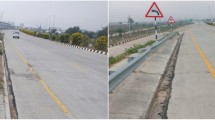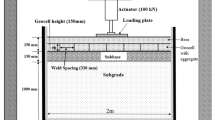Abstract
Frequent flooding and wet weather events are the challenges for managing road infrastructure. In this study, falling weight deflectometer (FWD) equipment is employed to investigate the effect of moisture consequence of January 2011 flood at Queensland, Australia on a flooded road. The impacts of the flood on the structural strength were obtained for the whole section as well as different layers individually. These two sets of data provide a clear picture of the road condition as sound, severe or warning before and after the maintenance of the road. Furthermore, the moisture content of the spotted road at field condition providing the structural stiffness was obtained with a correlation of FWD data. These analysis and investigations play an essential role in optimizing the maintenance method for the roads suffering from the flood.
Similar content being viewed by others
References
F. Lekarp, U. Isacsson, A. Dawson, State of the art I: Resilient response of unbound aggregates, J. Transp. Eng. 126 (1) (2000) 66–75.
S. Erlingssson, Impact of Water on the Response and Performance of Pavement Structure in an Accelerated Test, Road Mater. Pavement Des. 11 (4) (2010) 863–880.
M.B. Mndawe, J.M. Ndambuki, W.K. Kupolati, A.A. Badejo, Assessment of The Effects of Climate Change on the Performance of Pavement Subgrade, African J. Sci. Technol. Innov. Develop. 7 (2) (2015) 111–115.
Bureau of Meteorology, Flood summary for the Brisbane River at Brisbane City, Australian government, Brisbane, Australia, 2011.
Interim Report, 1 August 2011, Queensland Floods Commission of Inquiry, (Brisbane, Australia, 2011), http://www.floodcommission.qld.gov.au/publications/interim-report. Accessed 23 August 2011.
M. Sultana, G. Chai, S. Chowdhury, T. Martin, Deterioration of flood affected Queensland roads-An investigative study, Griffith University, Brisbane, Australia, Inter. J. Pavement Res. Technol. 9 (6) (2016) 424–435.
F. Praticò, S. Saride, A. Puppala, Comprehensive life-cycle cost analysis for selection of stabilization alternatives for better performance of low-volume roads, Transp. Res. Rec. 2204 (2011) 120–129.
Transportation Research Board, Pavement Lessons Learned from the AASHO Road Test and Performance of the Interstate Highway System, National Academy of Sciences, Washington DC, USA, 2007.
K. G. Sharp, Full Scale Accelerated Pavement Testing: a Southern Hemisphere and Asian Perspective, 2nd International Conference on Accelerated Pavement Testing, Minneapolis, MN, USA, 2004.
D. Bodin, J. Grenfell, G. Jameson, Deformation Performance of Foamed Bitumen Stabilised Pavements Under ALF Full-Scale Accelerated Loading. In: Chabot A., Hornych P., Harvey J., Loria-Salazar L. (eds) Accelerated Pavement Testing to Transport Infrastructure Innovation, Lecture Notes in Civil Engineering, vol 96. Springer, Cham. (2020) https://doi.org/10.1007/978-3-030-55236-7_31
S. Zaghloul, A. Ayed, Z. Ahmed, B. Henderson, J. Springer, N. Vitillo, Effect of positive drainage on flexible pavement life-cycle cost, Transp. Res. Rec. 1868 (2004) 135–141.
I. L. Al-Qadi, S. Lahouar, Measuring layer thicknesses with GPR — Theory to practice, Constr. Build. Mater. 19 (10) (2005) 763–772.
T. Saarenketo, T. Scullion, Road evaluation with ground penetrating radar, J. Appl. Geophys. 43 (2–4) (2000) 119–138.
W. Muller, H. Bhuyan, A. Scheuermann, A comparison of modified free-space (MFS), GPR, and TDR techniques for apparent dielectric constant characterisation of unbound granular pavement materials, Near Surface Geophys. 14 (6) (2016) 537–550.
M. B. Roslee, R. S. A. Raja Abdullah, H. Z. B. M. Shafr, Road Pavement Density Analysis Using a New Non-Destructive Ground Penetrating Radar System, Prog. Electromagnet. Res. 21 (2010) 399–417.
H. Bhuyan, A. Scheuermann, D. Bodin, R. Becker, Soil Moisture and Density Monitoring Methodology using TDR measurements, Inter. J. Pavement Eng. (2018) https://doi.org/10.1080/10298436.2018.1537491
H. Bhuyan, A. Scheuermann, D. Bodin, R. Becker, Use of Time Domain Reflectometry to estimate Moisture and Density of Unbound Road Materials: Laboratory Calibration and Real Field Investigation, Transp. Res. Rec. 2655 (2017) 71–81.
H. Bhuyan, A. Scheuermann, D. Bodin, T. Bore, Z. Chen, J. Nguyen, Introduction of flat ribbon cable (FRC) sensor for density measurement of road materials using time domain reflectometry (TDR), Proceedings 19th Inter. Conf. Soil Mech. Geotech. Eng., Seoul, Korea, 2017, pp. 1341–1344.
H. Bhuyan, A. Scheuermann, P.N. Mishra, D. Bodin, R. Becker, Flat Ribbon Cable Sensors for measurement of Soil Electrical Conductivity Using Time Domain Reflectometry, Inter. J. Geotech. Eng. (2018) https://doi.org/10.1080/19386362.2018.1429703
T. Bore, H. Bhuyan, T. Bittner, V. Murgan, N. Wagnerand, A. Scheuermann, A large coaxial reflection cell for broadband dielectric characterization of coarse-grained materials, Measurement Science and Technology. 29 (1) (2017) https://doi.org/10.1088/1361-6501/aa9407
T. Bore, H. Bhuyan, T. Bittner, A. Scheuermann, N. X. Wagner, EM Characterization of Coarse-Grained Soils with a One Port Large Coaxial Cell, 12th Inter. Conf. EM Wave Interaction with Water and Moist Substances (ISEMA), Lublin, Poland, 2018 https://doi.org/10.1109/ISEMA.2018.8442281.
E. Horak, Aspects of Deflection Basin Parameters used in a Mechanistic Rehabilitation Design Procedure for Flexible Pavements in South Africa, (PhD thesis), Department of Civil Engineering at the University of Pretoria, Pretoria, South Africa, 1988.
J. H. Maree, R. J. L. Bellekens, The effect of asphalt overlays on the resilient deflection bowl response of typical pavement structures. RP90/102. Chief Directorate National Roads, Pretoria, South Africa, 1991.
E. Horak, S. Emery, Falling weight deflectometer bowl parameters as analysis tool for pavement structural evaluations, 22nd ARRB Conference-Research into Practice, Canberra, Australia, 2006.
Texas Department of Transportation, Frequently Asked Questions about the Falling Weight Deflectometer (FWD), TXDOT, TX, USA, 2008.
Austroads, Austroads test method pavement deflection measurement with a falling weight deflectometer (FWD). AG:AM/T006, Sydney, Australia, 2011.
Brisbane City Council, Pavement Evaluation Report, Brisbane, Australia, 2011.
G. Gallage, T. Eom, D. Barker, J. Ramanujam, Falling Weight Deflectometer (FWD) tests on Granular Pavement Reinforced with Geogrids-Case study. In Kulathilaka Athula (Ed.), Proc. Inter. Conf. Geotech. Eng., Geotech. Sustain. Develop., Colombo, Srilanka, 2015, pp. 597–600.
R. Hadidi, N. Gucunski, Comparative study of static and dynamic falling weight deflectometer back-calculations using probabilistic approach, J. Transp. Eng. 136 (3) (2010) 196–204.
R. W. Meier, Back-calculation of flexible pavement moduli from falling weight deflectometer data using artificial neural networks. Technical Rep. GL 95. U.S. Army Corps of Engineers, Washington DC, USA, 1995.
H. Emile, E. Stephen, Falling Weight Deflectometer Bowl Parameters as Analysis Tool for Pavement Structural Evaluations, 22nd ARRB Conference-Research into practice, Canberra, Australia, 2006.
G. W. Chai, G. Kelly, T. T. Huang, S. H. Chowdhury, A. Golding, S. Manoharan, New approaches for modelling subgrade nonlinearity in thin surfaced flexible pavements, Inter. J. Pavement Eng. 19 (2) (2018) 122–130 https://doi.org/10.1080/10298436.2016.1172706
G. W. Chai, Kelly, G. Characterization of LTPP Pavements using Falling Weight Deflectometer, 6th Inter. Conf. Pavement Technol., Sapporo, Japan, 2008.
QDMR (Queensland Department of Main Roads), Pavement Design Manual, Department of Main Roads, Brisbane, Australia, 1990.
Acknowledgement
The authors of this papers acknowledge the support of the Brisbane City Council (BCC) in undertaking this project. A special gratitude goes to Greg Stephenson for his provision.
Author information
Authors and Affiliations
Corresponding author
Additional information
Peer review under responsibility of Chinese Society of Pavement Engineering.
Rights and permissions
About this article
Cite this article
Bhuyan, M.H., Deng, Y. & Scheuermann, A. Strength analysis of a partially-flooded pavement using falling weight deflectometer test before and after maintenance. Int. J. Pavement Res. Technol. 14, 428–436 (2021). https://doi.org/10.1007/s42947-020-0295-6
Received:
Revised:
Accepted:
Published:
Issue Date:
DOI: https://doi.org/10.1007/s42947-020-0295-6




